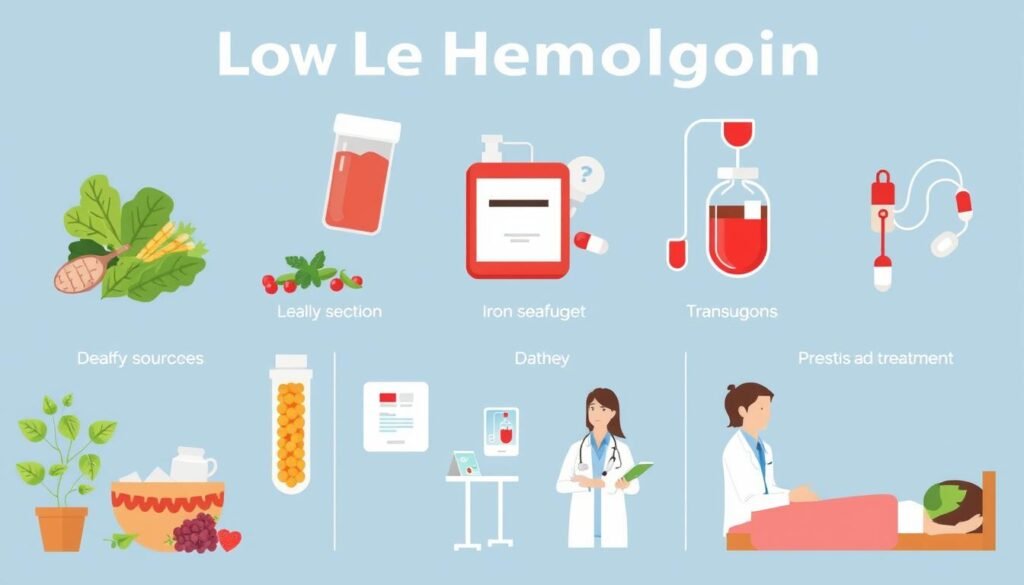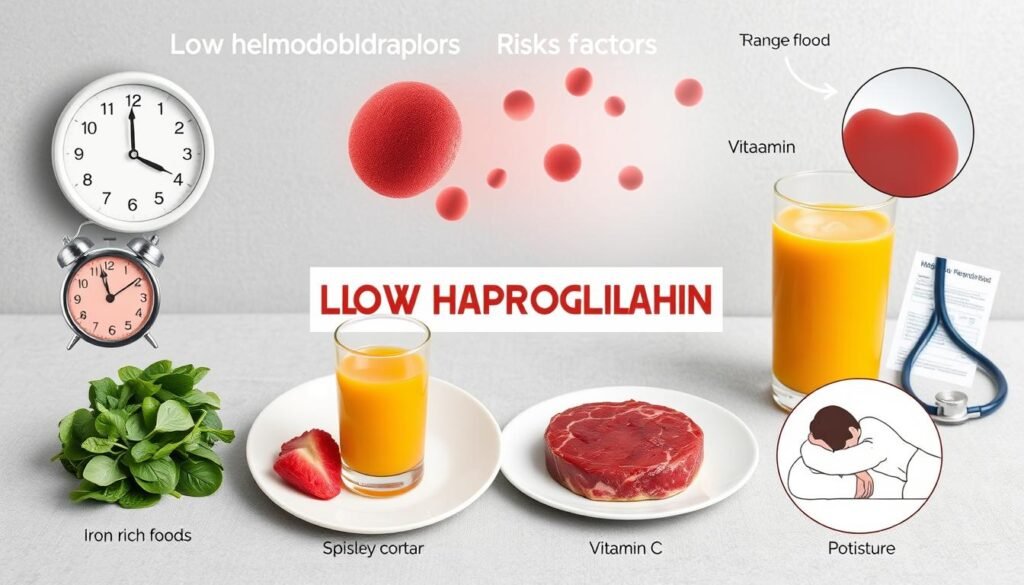About 3 million people in the United States suffer from anemia. This condition means you have not enough healthy red blood cells or hemoglobin. If not tackled, it can lead to health concerns. Hemoglobin is crucial for oxygen transport in the body.
When hemoglobin levels drop, symptoms like fatigue, breathlessness, and pale skin appear. There are many reasons for low hemoglobin. These include iron or vitamin deficiencies, chronic diseases, and genetic issues.
It’s vital to know the signs, causes, and ways to treat low hemoglobin. Proper management can boost hemoglobin levels and life quality. Improving health means dealing with anemia’s symptoms and its causes.
Key Takeaways
- Low hemoglobin is a prevalent issue impacting millions in the United States.
- Anemia symptoms include fatigue, pallor, and shortness of breath.
- Iron deficiency is the most common cause of low hemoglobin.
- Effective treatment of low hemoglobin typically involves dietary changes and supplements.
- Chronic medical conditions can significantly influence hemoglobin levels.
Understanding Anemia and Low Hemoglobin
Anemia involves not having enough healthy red blood cells or hemoglobin. This can hugely impact a person’s health and energy levels. Red blood cells carry oxygen all over the body with the help of hemoglobin. A drop in hemoglobin means not enough oxygen gets to the body’s organs and tissues.
Many things can cause low hemoglobin levels, such as nutritional deficits. Lack of iron, folate, or vitamin B12 can mean fewer red blood cells are made. Iron deficiency anemia is very common and can come from a poor diet or ongoing blood loss. Other types, like chronic disease anemia or microcytic anemia, are linked to health problems like thalassemia and lead exposure. Knowing what causes anemia is key to preventing and treating it.
Anemia is a global issue, affecting up to a third of all people. It’s even more common in certain groups, like nursing home residents, where 50%-60% might have it. Over 20% of people older than 85 have anemia. It’s also a big risk for women who can have babies and those who are pregnant.
Understanding different anemia types and causes is crucial. It leads us to look after our nutrition and health better. Since healthy red blood cells are needed for our bodies to work well, knowing about anemia is an important part of taking care of ourselves.
| Population Group | Prevalence of Anemia |
|---|---|
| Global Population | Up to 33% |
| Nursing Home Residents | 50%-60% |
| Elderly (Age > 85) | More than 20% |
| Women of Reproductive Age | Common |
| Pregnant Women | Common |
Signs and Symptoms of Low Hemoglobin
It’s key to know the signs of low hemoglobin for good health. People often ignore mild anemia symptoms. Signs like fatigue might not worry you but show your body is working hard to get enough oxygen. When things get worse, other symptoms may tell you it’s time to see a doctor.
Common Symptoms to Look Out For
Fatigue is a main sign of low hemoglobin. Those who have it might feel:
- Weakness during day-to-day tasks, making simple activities hard.
- Shortness of breath with little effort, showing the body’s struggle for oxygen.
- Pale skin, which can come from less blood flow or oxygen.
Noticing these signs early can help catch the problem sooner. This makes treatment more effective.
Severe Symptoms and Their Implications
Ignoring early anemia signs can lead to worse symptoms. Those with low hemoglobin might have:
- Rapid or uneven heartbeats, showing the heart working hard to move oxygen-rich blood.
- Dizziness or feeling light-headed, which can make you more likely to fall.
- Cold hands and feet, due to poor blood flow.
- Frequent headaches, because the brain isn’t getting enough oxygen.
These serious symptoms mean you need medical help fast, especially if they stop you from doing everyday things or point to other health issues. Knowing these signs can lead to faster treatment and healing.
What Causes Hemoglobin to be Low?
A variety of factors can cause low hemoglobin levels, affecting your health. It’s key to know these causes for proper anemia management.
Iron Deficiency and Its Impact
Iron deficiency is a major reason for low hemoglobin. Our bodies need iron to make hemoglobin, which carries oxygen in red blood cells. If we don’t get enough iron, we may develop iron deficiency anemia. This problem comes from different sources:
- Diets low in iron: Some people don’t eat enough iron-rich food, like red meat, beans, and cereals that have extra iron.
- Blood loss: Losing a lot of blood through things like heavy periods, injuries, or internal bleeding from an ulcer can cause this issue.
If you ignore iron deficiency, it could lead to even worse health problems. So, keeping up with your iron is important to avoid anemia.
Vitamin Deficiencies: B12 and Folate
Vitamin deficiencies can also block red blood cell production. You need enough vitamin B12 and folate for your body to make these cells properly. If you don’t get enough, it can cause a type of anemia. The reasons for these shortages include:
- Poor dietary choices: Not eating foods with B12, like meat and dairy, or not enough folate from greens can cause these deficiencies.
- Absorption issues: Diseases like celiac or atrophic gastritis can stop your body from taking in these vitamins well.
Dealing with iron and vitamin shortages is key for anyone with low hemoglobin. These issues greatly affect your blood’s health.
How Low Hemoglobin Affects the Body
Low hemoglobin levels have significant effects of low hemoglobin on how our bodies work. This condition means less oxygen goes to vital tissues and organs. With less oxygen, people often feel tired and find daily tasks hard.
Not enough oxygen also harms other body functions. It can weaken the mind, affecting focus and decisions. It might even make you more likely to get sick. If not treated, this can lead to serious problems like extreme fatigue, pregnancy issues, and dangerous conditions.
Taking care of effects of low hemoglobin is key for good health. Seeing a doctor regularly and eating right can help prevent and manage anemia. Foods rich in iron, vitamin B-12, and folate are especially important for oxygen delivery.
If you feel dizzy, look pale, or your heart beats oddly, see a doctor soon. Finding out the kind of anemia is the first step to getting better. A balanced lifestyle, including enough rest and the right foods, can help fix low hemoglobin. This improves health overall.
| Hemoglobin Levels (g/dL) | Classification | Potential Impact |
|---|---|---|
| 13.5 – 17.5 (Male) | Normal | Optimal oxygen delivery |
| 12.0 – 15.5 (Female) | Normal | Optimal oxygen delivery |
| 8 – 10 | Moderately Low | Increased fatigue and weakness |
| 6.5 – 7.9 | Concerning | Risk of serious complications |
| Less than 6.5 | Life-threatening | Critical intervention needed |
Knowing how anemia affects you could push you to get help early. Getting the right treatment and making changes in your life can greatly improve your body’s function.
Diagnosis of Low Hemoglobin Levels
To find out if you have low hemoglobin, you start with a complete blood count (CBC) test. This test checks for several things including your red blood cells and hemoglobin. It helps find the cause of anemia. Knowing what your blood tests show is key in figuring out how to treat it.
Blood Tests and What They Reveal
Several blood tests offer clues about your hemoglobin and overall blood health. Important tests include:
- Reticulocyte count to evaluate red blood cell production.
- Serum iron and ferritin tests to assess iron levels.
- Peripheral blood smear to assess the shape and structure of red blood cells.
- Hemoglobin electrophoresis to identify any abnormal hemoglobin.
- Osmotic fragility test to evaluate the fragility of red blood cells.
These tests help doctors figure out which type of anemia you have and why. Diagnosis becomes clearer with this info.
Understanding Your Test Results
Interpreting your test results means looking at hemoglobin levels, hematocrit, and red blood cell counts. Anemia’s definition differs between men and women. For men, it’s hemoglobin below 13.6 g/dL. For women, it’s below 12 g/dL.
By identifying if red blood cells are too big, too small, or normal, one can pinpoint the type of anemia. Doctors also look at symptoms and your health history. This way, they can make a good treatment plan for you.
Treating Low Hemoglobin: An Overview
Treating low hemoglobin is key to good health. It means finding out why anemia is happening. There are many ways to treat it, like changing your diet and taking supplements. This helps your body make more healthy red blood cells.
Dietary Changes to Boost Hemoglobin
Eating iron-rich foods is very important to increase hemoglobin. You should eat:
- Red meat
- Leafy greens, such as spinach and kale
- Beans and lentils
- Fortified cereals
- Fish and poultry
Dietary changes aren’t just about adding iron. They also help your body absorb nutrients better. Add foods high in vitamin C, vitamin A, and beta-carotene. They help your body use the iron from food better.
Iron Supplements and Their Use
Sometimes, iron supplements are needed. This happens when food isn’t enough to raise iron levels. Supplements slowly increase iron over weeks. But, it’s important to watch how much you take. Too much iron can cause problems like hemochromatosis and liver disease.
If you’re not getting enough vitamins, extra supplements might help. For example, people low in vitamin B12 or folate can get better by taking supplements. They should also make diet changes. It’s important to look at all treatment options. And, always check with doctors or trusted sources like the Mayo Clinic for the best advice on treating anemia.

Types of Anemia Related to Low Hemoglobin
Anemia includes different conditions with low hemoglobin levels. Knowing these types of anemia is key for correct diagnosis and treatment. Iron deficiency anemia and vitamin deficiency anemia are two common types. They affect the body differently.
Iron Deficiency Anemia
Iron deficiency anemia is quite common. It often comes from not getting enough iron or from losing too much blood. The condition makes red blood cells smaller. Low iron levels mean less hemoglobin, which affects oxygen transport in blood.
Poor diet, heavy menstrual cycles, and stomach problems can cause this. If iron deficiency anemia gets worse, you might need to change your diet or lifestyle.
Vitamin Deficiency Anemia
Lacking important vitamins, like B12 and folate, leads to vitamin deficiency anemia. This lack stops the body from making enough red blood cells, which then grow too big. Pernicious anemia, a special case, hurts vitamin B12 absorption and can damage nerves badly if ignored.
Getting enough vitamins, from food or pills, can stop and fix this type of anemia. For more info on anemia symptoms and treatments, visit this resource.
Sickle Cell Anemia and Other Types
Sickle cell anemia comes from a gene change. It makes red blood cells shape weird, blocking blood flow and causing pain. It shows the variety in anemia types, including genetic and acquired ones. There’s hemolytic anemia, aplastic anemia, and more from chronic diseases or outside factors.
Each anemia type has its own challenges and treatment plans, specific to the person’s condition.
Risk Factors for Low Hemoglobin
Many things can cause low hemoglobin levels. These include diet issues and long-lasting health problems. Knowing what causes low hemoglobin helps people take steps to keep their levels healthy.
Diet and Nutritional Considerations
Eating the right foods is key to avoiding low hemoglobin. Not getting enough iron, Vitamin B12, and folate can lead to anemia. This is especially true for vegetarians and those with special diets. Adding iron-rich foods like greens, beans, and meats to your diet is important. Learning about the risk factors can guide your food choices.
Chronic Conditions Impacting Hemoglobin Levels
Long-term illnesses like kidney disease, cancer, and inflammation can affect red blood cells. These problems can destroy red blood cells or stop them from being made. This makes the risk of low hemoglobin go up. People with autoimmune diseases or who are often sick should watch their health closely. They should get regular check-ups to keep an eye on their hemoglobin. Knowing about these risks can help you manage your health better.

Complications of Low Hemoglobin
Low hemoglobin levels can cause serious problems. These issues greatly affect daily life and health. For example, one major problem is feeling very tired. With not enough hemoglobin, your body doesn’t get the oxygen it needs. This makes doing everyday activities hard. It affects both how well you can move and think.
Fatigue and Impaired Daily Activities
People with low hemoglobin often feel very tired. This tiredness shows up in different ways:
- Less energy
- Hard time focusing
- Feeling more easily annoyed
- Getting winded from exercise
This tiredness makes it hard to do normal tasks. It can make you less productive and happy. When you’re always tired, joining in on fun activities or meeting obligations feels too hard. This can make you feel lonely or even sad.
Impact on Heart Health
Low hemoglobin is risky for your heart. To make up for the lack of oxygen, your heart pumps harder. This puts a lot of extra work on it. Over time, this can cause big problems, like:
- Irregular heartbeats
- A bigger heart
- Heart failure
This extra stress on the heart can be very harmful. This is especially true for people who already have health issues. So, it’s important to manage low hemoglobin to keep your heart and body healthy.
Lifestyle Changes to Manage Low Hemoglobin
Lifestyle changes are key to handling low hemoglobin levels. Eating foods rich in iron, folate, and vitamin B12 is crucial. Try adding red meat, poultry, fish, and various plant-based options like beans and spinach to your diet. These foods are especially vital for pregnant women to support their baby’s growth.
Exercise helps too, as it boosts circulation and overall health. Be mindful about your energy levels when you start working out. Cutting down on smoking and drinking can also help raise your hemoglobin. These changes don’t just help with hemoglobin; they make you healthier overall.
Keeping track of your health with blood tests is smart. It lets you know if your hemoglobin levels are low. This is important because anemia can be hard to spot. Knowing your hemoglobin level helps you make needed changes or seek medical advice.

Vegetarians might need to talk to doctors about their diet or iron supplements. A healthy lifestyle with the right diet and wellness habits can prevent iron deficiency. It also boosts your energy levels.
Preventive Measures Against Low Hemoglobin
To keep healthy, fighting low hemoglobin is key. A big part of this is eating well. Such diets boost red blood cell production. They help avoid anemia by linking good eating with proper hemoglobin levels.
Importance of a Balanced Diet
Iron-rich foods are crucial for good hemoglobin. These include:
- Red meat
- Poultry
- Fish
- Beans and lentils
- Leafy green vegetables like spinach
- Fortified cereals
Add folate from oranges and avocados for better iron absorption. Vitamin B12, found in dairy and eggs, is also needed. Including Vitamin C-rich foods like tomatoes and bell peppers helps. This mix strengthens our fight against anemia.
When to Seek Medical Advice
Knowing low hemoglobin symptoms is critical for catching it early. Look out for fatigue, pale skin, fast heartbeat, and dizziness. If these signs show up and don’t go away, it’s time to see a doctor. Regular doctor visits and blood tests are good. They let us adjust our diet or start needed treatment.
| Preventive Measure | Description |
|---|---|
| Balanced Diet | Includes iron, folate, and vitamin B12 sources to support hemoglobin production. |
| Regular Check-ups | Monitor hemoglobin levels and overall health to detect any deficiencies early. |
| Hydration | Maintaining adequate fluid intake aids overall bodily functions and blood circulation. |
| Awareness of Symptoms | Recognizing signs of anemia ensures timely medical advice and intervention. |
Conclusion
Knowing about low hemoglobin is key to staying healthy. Anemia shows up through different signs, linked to what we eat or long-term illnesses. Spotting these early means people can get the right help, improving how they manage this issue.
Eating foods rich in iron and taking supplements is important. Because low hemoglobin affects how much oxygen reaches our body, these steps can really help. Also, changing our lifestyle helps us take control of our health and lower anemia risks.
Anemia affects many people differently. It’s important to watch for symptoms and act on them. Making smart food choices, using supplements, and keeping healthy habits can make life better. In the end, knowing and tackling low hemoglobin boosts our health and makes life brighter.